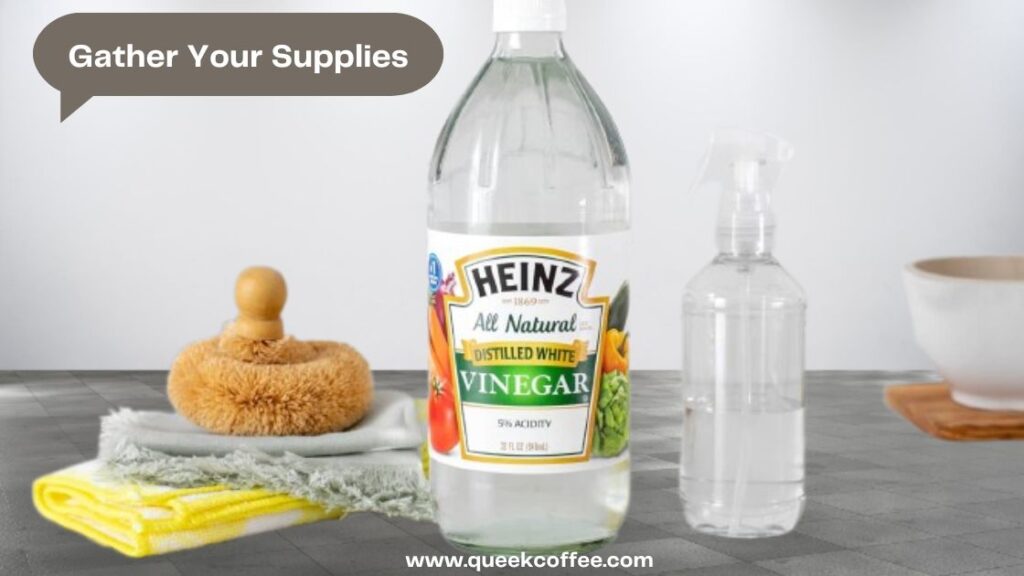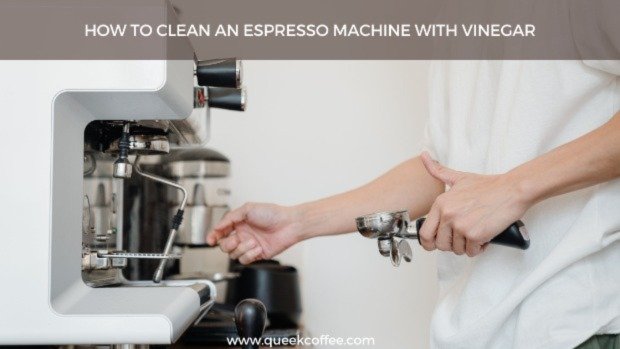Are you a coffee lover who enjoys the rich aroma and flavor of a perfect espresso? If so, you probably know the importance of keeping your espresso machine clean. Regular cleaning not only ensures optimal performance but also prolongs the lifespan of your machine.
In this guide, we will show you how to clean an espresso machine using vinegar, a simple and effective method that can remove built-up residue and mineral deposits.
How Does an Espresso Machine Work?

An espresso machine is a marvel of engineering that brings together art and science to deliver that perfect shot of espresso. Understanding how an espresso machine works can deepen your appreciation for the intricate process behind crafting this beloved beverage.
At its core, an espresso machine operates on the principle of passing pressurized hot water through finely-ground coffee, resulting in a concentrated and flavorful espresso shot. Here’s a simplified breakdown of the key components and steps involved in the espresso-making process:
- Water Reservoir: The machine is equipped with a water reservoir where clean water is stored for brewing.
- Pump: A powerful pump pressurizes the water, usually at around 9 bars of pressure. This pressure is necessary for extracting the flavors from the coffee grounds.
- Boiler: The machine has a boiler that heats the water to the ideal brewing temperature, typically between 195°F and 205°F (90°C to 96°C). The water is heated and maintained at this temperature for consistent extraction.
- Portafilter: The portafilter is a handle with a filter basket attached. Ground coffee is dosed into the basket and then evenly distributed and tamped to ensure proper extraction.
- Group Head: The portafilter locks into the group head, which is a metal component that directs the pressurized water into the coffee grounds.
- Extraction: When the machine is activated, the pump forces the hot, pressurized water through the compacted coffee grounds in the portafilter. The water extracts the flavors and oils from the coffee, resulting in a concentrated espresso shot.
- Espresso Shot: The extracted espresso flows out of the portafilter and into a waiting cup, producing a rich, flavorful, and aromatic beverage.
- Steam Wand: Many espresso machines feature a steam wand, which is used to froth and heat milk for creating various espresso-based drinks like cappuccinos and lattes.
The beauty of an espresso machine lies in the precision and control it provides, allowing baristas and coffee enthusiasts to fine-tune variables such as water temperature, extraction time, and grind size to achieve the desired flavor profile. So, the next time you savor a delightful cup of espresso, take a moment to appreciate the intricate workings of the espresso machine that made it possible.
Understanding the Cleaning Process

For a number of reasons, regular espresso machine cleaning is essential. In the first place, it assists in preserving the flavor and quality of your coffee by getting rid of any accumulated coffee oils, residue, and mineral deposits that may have a detrimental effect on the flavor.
Regular cleaning also assists in avoiding clogs, blockages, and any faults that may result from slack maintenance. Why then do you consistently use vinegar as a cleaning agent? Vinegar is a natural and efficient cleaning agent, particularly white distilled vinegar. Its acidic qualities ensure a thorough and hygienic cleaning by helping to dissolve tough deposits and get rid of bacteria.
In addition, it is easily accessible in the majority of homes, making it a practical and cost-effective choice for barista enthusiasts. To use vinegar for cleaning, you must, however, exercise caution and follow the correct procedures, which we’ll go over in more depth later. Get ready to learn how vinegar can keep your espresso machine clean and the perfect cup of espresso shot.
Step-by-Step Guide to Clean an Espresso Machine
Follow these easy steps to keep your espresso machine in top shape and enjoy delicious cups of coffee every time.
Step 1: Gather Your Supplies

Before getting started on your espresso machine cleaning journey with vinegar, it’s important to gather all the necessary supplies. Here are the items you’ll need:
- White distilled vinegar: Look for a high-quality, unfiltered variety to ensure optimal cleaning results.
- Water: Preferably filtered or distilled water to avoid any mineral build-up during the cleaning process.
- Cleaning brush: A small brush with soft bristles for scrubbing hard-to-reach areas.
- Microfiber cloth: Ideal for wiping down surfaces and removing any residue.
- Cleaning detergent (optional): If you prefer a milder cleaning solution, you can opt for a specialized espresso machine cleaning detergent.
- Rubber gloves: To protect your hands from any harsh chemicals or hot water.
Once you have these supplies ready, you’ll be fully equipped to give your espresso machine the thorough cleaning it deserves. So, let’s move on to the step-by-step guide and transform your machine into a sparkling haven for brewing exceptional espresso.
Step 2: Prepare the Vinegar Solution
To create the vinegar-cleaning solution, follow these measurements:
- For manual espresso machines: Mix equal parts white vinegar and water.
- For automatic espresso machines: Use one part vinegar to two parts water.
Measure the appropriate amounts of vinegar and water into a container and mix them thoroughly.
Step 3: Empty the Machine and Remove Parts
Before cleaning, ensure that the espresso machine is turned off and unplugged. Empty the water reservoir and remove any remaining coffee grounds. Detach the portafilter, the filter basket, and any other removable parts according to your machine’s instructions.
Step 4: Soak Removable Parts
Take the removable parts and submerge them in the vinegar solution. Let them soak for about 20 minutes. This will help dissolve any coffee residue and mineral deposits that have accumulated.
Step 5: Clean the Group Head and Portafilter
While the removable parts are soaking, focus on cleaning the group head and portafilter. Dampen a clean cloth or sponge with the vinegar solution and wipe the surfaces thoroughly. Pay attention to any nooks and crannies where coffee residue may be present. Rinse the cloth or sponge frequently to avoid spreading the residue.
Step 6: Scrub and Rinse Removable Parts
After soaking for 20 minutes, remove the removable parts from the vinegar solution. Use a soft brush to scrub them gently, removing any remaining residue. Rinse the parts under running water to ensure all traces of vinegar are gone.
Step 7: Run a Vinegar-Water Solution Through the Machine
Pour the remaining vinegar solution into the water reservoir of the espresso machine. Turn on the machine and run a brew cycle without any coffee grounds. This will allow the solution to circulate through the internal components and clean them.
Step 8: Rinse the Machine
Repeat the process using clean water once the vinegar solution has gone through the machine. Fill the water reservoir with fresh water and run a few brew cycles to rinse out any leftover vinegar. This step is crucial to ensure there is no vinegar taste in your next cup of espresso.
Step 9: Clean External Surfaces
While the machine is still damp, use a clean cloth or sponge to wipe down the external surfaces. Remove any stains or spills, and ensure the machine looks sparkling clean.
Step 10: Reassemble and Test
Allow all the parts to air dry completely. Once dry, reassemble the machine according to the manufacturer’s instructions. Plug it back in, fill the water reservoir, and run a test brew to ensure everything is functioning correctly.
Congratulations! You have successfully cleaned your espresso machine using vinegar. Regular maintenance like this will keep your machine running smoothly and ensure the best-tasting espresso for years to come.
Troubleshooting Tips
While cleaning your espresso machine with vinegar is generally straightforward, you may encounter some challenges along the way. Here are a few troubleshooting tips to help you overcome common issues:
- Issue: Lingering vinegar smell or taste in the coffee.
- Solution: Run multiple cycles of clean water through the machine to thoroughly rinse out any vinegar residue.
- Issue: Clogs or blockages in the pipes or group head.
- Solution: Use a small brush or a pin to carefully remove any debris or build-up in the affected areas. Ensure proper water flow before using the machine again.
- Issue: Difficulty in removing stubborn stains or residue.
- Solution: Increase the soaking time of the removable parts in the vinegar-water solution to loosen the build-up. Scrub gently with a brush or cloth for better results.
- Issue: The machine not functioning properly after cleaning.
- Solution: Double-check that all parts are reassembled correctly and securely. Refer to the machine’s manual for troubleshooting specific issues.
Preventative maintenance tips:
- Regularly backflush your espresso machine to prevent build-up in the group head.
- Clean the steam wand after each use to avoid milk residue accumulation.
- Use filtered or distilled water to minimize mineral deposits.
- Follow a regular cleaning schedule to prevent excessive build-up and ensure optimal performance.
By troubleshooting any issues that arise during the cleaning process and implementing preventative maintenance practices, you’ll keep your espresso machine running smoothly and consistently producing delicious cups of coffee.
Final Thoughts
Cleaning your espresso machine with vinegar is a simple and effective method. By following the steps outlined in this guide, you can maintain the cleanliness of your machine and enjoy the perfect espresso experience every time. Remember to clean your espresso machine regularly to avoid any build-up or clogging issues. Happy brewing!
FAQs
How often should I clean my espresso machine with vinegar?
It is generally recommended to clean your espresso machine with vinegar every 1-3 months, depending on your usage. However, it’s important to follow the manufacturer’s guidelines and recommendations specific to your machine. Some machines may require more frequent cleaning if you use hard water or if you notice a significant build-up of coffee oils and residue. Regular cleaning helps maintain the quality of your espresso and prolongs the lifespan of your machine.
Can I use any type of vinegar for cleaning my espresso machine?
While white distilled vinegar is the most commonly used vinegar for cleaning an espresso machine, it is important to consult your machine’s manual for specific recommendations. Some manufacturers may advise against using vinegar, or they may recommend using a specific type of vinegar. Additionally, be cautious about using other flavored or infused vinegar, as they may leave behind unwanted flavors or residues in your machine.
Are there any alternatives to vinegar for cleaning my espresso machine?
Yes, there are alternative cleaning solutions available specifically formulated for espresso machine cleaning. These cleaning detergents are designed to remove coffee oils, scale, and residue effectively. They often come in powder or tablet form, and you can follow the instructions provided by the manufacturer.
However, keep in mind that these products may be more expensive than vinegar and may require rinsing thoroughly to ensure no residue remains. Always check the compatibility of the cleaning product with your espresso machine before using it.

Mr. Haque is an Operations Manager at a reputed bank. During the weekends, Haque spends his time tending to his rooftop with the coffee fans. During work days, relish a cup in the morning, both to get the day started and to enjoy the flavors.





